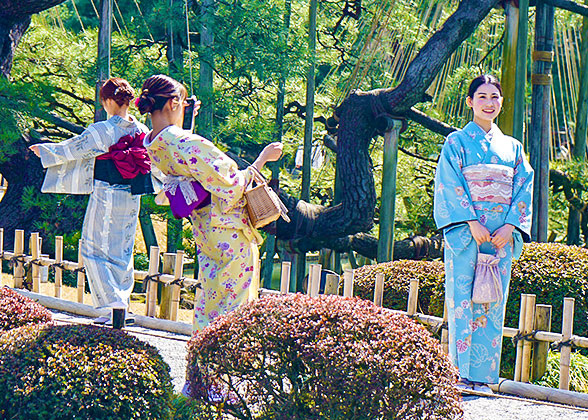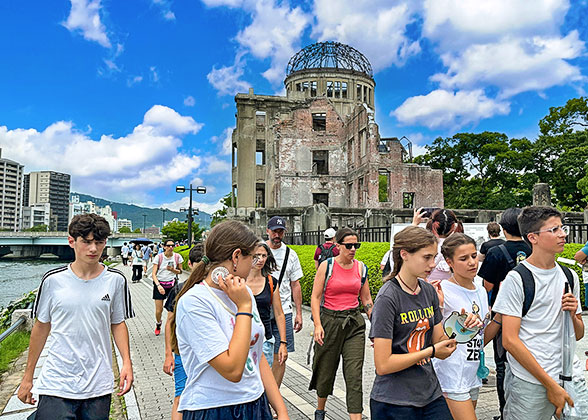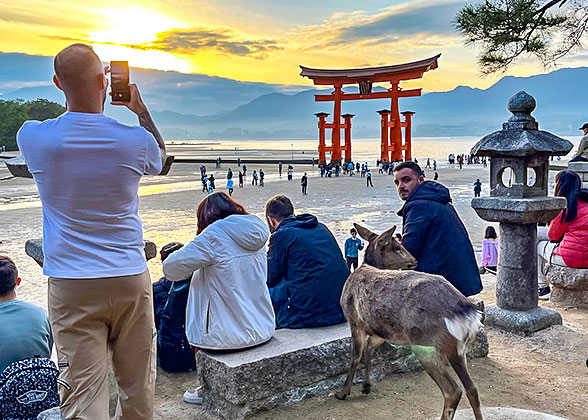- Attractions
- Weather
- Videos
- Photos
Hiroshima Weather
![]() Climatic Zone: subtropical monsoon climate
Climatic Zone: subtropical monsoon climate
 Average Temperature: 13 - 20℃ (55.4 - 68℉)
Average Temperature: 13 - 20℃ (55.4 - 68℉)
 Warmest Month: August: 26 - 32 ℃ (78.8 - 89.6℉)
Warmest Month: August: 26 - 32 ℃ (78.8 - 89.6℉)
 Coolest Month: January: 2 - 9℃ (35.6 - 48.2℉)
Coolest Month: January: 2 - 9℃ (35.6 - 48.2℉)
 Rainiest Months: June: 237.4 mm & July: 279.9 mm
Rainiest Months: June: 237.4 mm & July: 279.9 mm
 What is the weather like in Hiroshima?
What is the weather like in Hiroshima?
Spring is warm with relatively low precipitation. Besides, it is the season for appreciating cherry blossoms and various other flowers, while autumn is crisp and comfortable. Therefore, in these two seasons, in such comfortable temperatures, you can enjoy both the natural scenery and some cultural landscapes.
• Read more: Best Time to Visit Japan & Japan Weather
|
|
|




Spring: March - May
 Weather: mild and pleasant
Weather: mild and pleasant Temperature: 6-23℃ (42.8-73.4℉)
Temperature: 6-23℃ (42.8-73.4℉) Rainfall: 459.2 mm
Rainfall: 459.2 mm Rainy days in total: 30 days
Rainy days in total: 30 daysThe average temperature of Hiroshima in spring is warmly at 13-23℃ (55.4-73.4℉) in the daytime and 6-16℃ (42.8-60.8℉) at night. It should be noticed that the temperature difference between the daytime and evening is large. Overall, the temperature in spring of Hiroshima is pleasant and suitable for outdoor activities. As for rainfall, on average, the total rainfall in spring is 459.2 mm, which is relatively large. Therefore, it’s better to bring an umbrella at any time.
In the daytime, clothes like thin knitwears, thin sweaters, hoodies, and jeans can be worn; while at night, when the temperature goes down, thicker clothes like jackets should be put on. As for shoes, sneakers and walking shoes are needed.
Travel Recommendation and Tips:
1. From the second half of March, the cherry blossoms begin to bloom in Hiroshima, so from late March to mid-April is the best time to admire cherry blossoms there. Hiroshima Peace Memorial Park, Miyajima Island, etc. are recommended places.2. In early May 2025, the annual Hiroshima Flower Festival will be held, when you can see the parade and various floral decorations.

Cenotaph for the A-Bomb Victims of Hiroshima Peace Memorial Park
|
Summer: June - August
 Weather: hot and rainy
Weather: hot and rainy Temperature: 21-32℃ (69.8-89.6℉)
Temperature: 21-32℃ (69.8-89.6℉) Rainfall: 672.1 mm
Rainfall: 672.1 mm Rainy days: 34 days
Rainy days: 34 daysSummer is hot and has higher temperatures than other seasons, among which August is the hottest month with an average highest temperature of 32℃ (91.4℉). Besides, early June to mid-July is rainy season in general. In June and July, totally, the average rainfall exceeds 500 mm and the rainy days reach about 25 days, so the climate is humid, too. Moreover, in summer, Hiroshima may suffer from typhoons.
Clothes like breathable T-shirts, short shirts, skirts, shorts, dresses, and light pants can be packed if you plan to visit Hiroshima in summer. Besides, be sure to take sun protection items and raingear.
Travel Recommendation and Tips:
1. The Fireworks Festival is usually held in July and August.2. In summer, Itsukushima Shrine is a perfect place to go, where the temperature is lower than that of the inland areas. Moreover, you can step into the sea to take pictures together with the Otorii gate.

Otorii Gate of Itsukushima Shrine
|
Autumn: September - November
 Weather: warm, and moderate rainfall
Weather: warm, and moderate rainfall Temperature: 9-28℃ (48.2-82.4℉)
Temperature: 9-28℃ (48.2-82.4℉) Rainfall: 362 mm
Rainfall: 362 mm Rainy days: 24 days
Rainy days: 24 daysAutumn begins in September and ends in November. The weather cools down and becomes mild and pleasant for outing and traveling. As for the humidity, it decreases and comes to a moderate stage. From late October to November, maple leaves in various parts of Hiroshima turn red, providing beautiful autumn scenery for visitors.
At the beginning days of autumn, clothes like long-sleeve T-shirts, blouses, thin knitwear and jeans are suitable to wear. However, by the end of Autumn, when the temperature is lower, jackets, sweater and other thicker clothes need to be put on.
Travel Recommendation and Tips:
1. Autumn is the season for fatty bonito and saury, do not forget to have a taste.2. Miyajima Island has a perfect spot to appreciate these red leaves called “Momijidani Park”.
3. Hiroshima climate in autumn is perfect for visiting human landscapes like Hiroshima Peace Memorial Park.
|
|
|
Winter: December - February
 Weather: cold and little rainfall
Weather: cold and little rainfall Temperature: 2-12℃ (35.6-53.6℉)
Temperature: 2-12℃ (35.6-53.6℉) Rainfall: 197.2 mm
Rainfall: 197.2 mm Rainy days: 23 days
Rainy days: 23 daysIn December, the average temperature falls to 4-12℃ (39.2-53.6℉), and Hiroshima steps into winter, when the weather is cold and occasionally snowy. In Hiroshima, winter spans from December to February. Among them, January is the coldest month, whose average temperature does not exceed 10℃ (50℉). In January 2024, the lowest temperature once dropped to -2℃ (28.4℉). Winter has the smallest precipitation compared with other seasons: its monthly rainfall does not exceed 100 mm and the total rainy days are about 23 days on average.
To protect yourself from coldness, clothes like wool overcoats, downcoats and winter pants are needed. Besides, on the coldest days, you may need to put on a hat and scarf. In addition to these, on snowy days, you’d better put nonslip and convenient boots on.
Travel Recommendation and Tips:
1. Winter is the best time to eat Hiroshima’s representative seafood oysters and Hiroshima yaki.2. There are many hot springs in Hiroshima, where you can relax in the cold winter.
|
|
|
You May Like
-
 10 Days Private Tour for A Japan Panorama in Depth, with Hiroshima Highlights from USD3809
10 Days Private Tour for A Japan Panorama in Depth, with Hiroshima Highlights from USD3809 -
 8 Days Mini Group Tour: Tokyo - Hakone & Mt. Fuji - Kyoto - Nara - Osaka - Hiroshima - Osaka from USD2771
8 Days Mini Group Tour: Tokyo - Hakone & Mt. Fuji - Kyoto - Nara - Osaka - Hiroshima - Osaka from USD2771 -
 11 Days Mini Group Tour to Tokyo - Hakone (Mt. Fuji) - Kyoto - Nara - Osaka - Hiroshima... from USD3554
11 Days Mini Group Tour to Tokyo - Hakone (Mt. Fuji) - Kyoto - Nara - Osaka - Hiroshima... from USD3554


